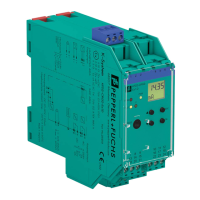2017-12
10
Functional Safety KF**-CRG2-(Ex)1.D
Planning
3.2 Assumptions
The following assumptions have been made during the FMEDA:
• Failure rate based on the Siemens standard SN29500.
• Failure rates are constant, wear is not considered.
• External power supply failure rates are not included.
• The collective error message output is not safety relevant.
• The indication of a dangerous failure (via fault bus) is detected within 1 hour by
the programmable logic controller (PLC).
• The safety-related device is considered to be of type B device with a hardware
fault tolerance of 0.
• The device will be used under average industrial ambient conditions, which
are comparable with the classification "stationary mounted" in
MIL-HDBK-217F. Alternatively, the following ambient conditions are assumed:
• IEC/EN 60654-1 Class C (sheltered location) with temperature limits in the
range of the manufacturer's specifications and an average temperature of
40 ºC over a long period. The humidity level is within manufacturer's rating.
For a higher average temperature of 60 ºC, the failure rates must be
multiplied by a factor of 2.5 based on experience. A similar factor must be
used if frequent temperature fluctuations are expected.
• Since the outputs of the device use common components, these outputs must
not be used in the same safety function.
• Features that extend the reaction time of the output are not considered within
the specified reaction time. It is the user's responsibility to consider this time
within the safety calculation.
• Observe the useful lifetime limitations of the output relays according to the
datasheet.
• The device must be configured for the required safety function before the
commissioning. During the operation any change of the configuration is not
allowed. See chapter 4.1.1.
• The device configuration is protected by a password against changing.
Analog Output
• The application program in the programmable logic controller (PLC) is
configured to detect underrange and overrange failures.

